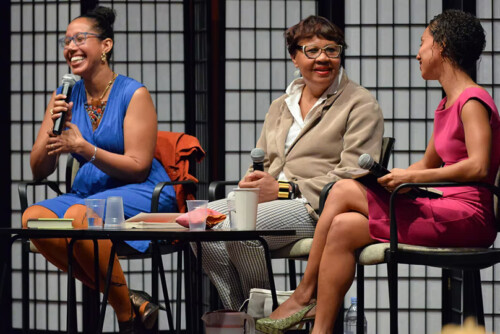Killjoys
To be unseated by the table of happiness might be to threaten not simply that table, but what gathers around it, what gathers on it. When you are unseated, you can even get in the way of those who are seated, those who want more than anything to keep their seats. To threaten the loss of the seat can be to kill the joy of the seated. How well we recognise the figure of the feminist killjoy! How she makes sense! Let’s take the figure of the feminist killjoy seriously. One feminist project could be to give the killjoy back her voice. Whilst hearing feminists as killjoys might be a form of dismissal, there is an agency that this dismissal rather ironically reveals. We can respond to the accusation with a “yes.”
The figure of the feminist killjoy makes sense if we place her in the context of feminist critiques of happiness, of how happiness is used to justify social norms as social goods (a social good is what causes happiness, given happiness is understood as what is good). As Simone de Beauvoir described so astutely “it is always easy to describe as happy a situation in which one wishes to place [others].” 1 Not to agree to stay in the place of this wish might be to refuse the happiness that is wished for. To be involved in political activism is thus to be involved in a struggle against happiness. Even if we are struggling for different things, even if we have different worlds we want to create, we might share what we come up against. Our activist archives are thus unhappy archives. Just think of the labor of critique that is behind us: feminist critiques of the figure of “the happy housewife;” Black critiques of the myth of “the happy slave”; queer critiques of the sentimentalisation of heterosexuality as “domestic bliss.” The struggle over happiness provides the horizon in which political claims are made. We inherit this horizon.
To be willing to go against a social order, which is protected as a moral order, a happiness order is to be willing to cause unhappiness, even if unhappiness is not your cause. To be willing to cause unhappiness might be about how we live an individual life (not to choose “the right path” is readable as giving up the happiness that is presumed to follow that path). Parental responses to coming out, for example, can take the explicit form not of being unhappy about the child being queer but of being unhappy about the child being unhappy. 2 Even if you do not want to cause the unhappiness of those you love, a queer life can mean living with that unhappiness. To be willing to cause unhappiness can also be how we immerse ourselves in collective struggle, as we work with and through others who share our points of alienation. Those who are unseated by the tables of happiness can find each other.
So, yes, let’s take the figure of the feminist killjoy seriously. Does the feminist kill other people’s joy by pointing out moments of sexism? Or does she expose the bad feelings that get hidden, displaced, or negated under public signs of joy? Does bad feeling enter the room when somebody expresses anger about things, or could anger be the moment when the bad feelings that circulate through objects get brought to the surface in a certain way? The feminist subject “in the room” hence “brings others down” not only by talking about unhappy topics such as sexism but by exposing how happiness is sustained by erasing the signs of not getting along. Feminists do kill joy in a certain sense: they disturb the very fantasy that happiness can be found in certain places. To kill a fantasy can still kill a feeling. It is not just that feminists might not be happily affected by what is supposed to cause happiness, but our failure to be happy is read as sabotaging the happiness of others.
We can consider the relationship between the negativity of the figure of the feminist killjoy and how certain bodies are “encountered” as being negative. Marilyn Frye argues that oppression involves the requirement that you show signs of being happy with the situation in which you find yourself. As she puts it, “it is often a requirement upon oppressed people that we smile and be cheerful. If we comply, we signify our docility and our acquiescence in our situation.” To be oppressed requires that you show signs of happiness, as signs of being or having been adjusted. For Frye “anything but the sunniest countenance exposes us to being perceived as mean, bitter, angry or dangerous”. 3
- Simone de Beauvoir, The Second Sex, trans. by H.M. Parshley (London: Vintage Books, 1997) 28.[↑]
- See, for example: Nancy Garden, Annie on My Mind (New York: Farrar, Straus & Giroux, 1982) 191.[↑]
- Marilyn Frye, The Politics of Reality: Essays in Feminist Theory (Trumansburg, New York: The Crossing Press, 1983).[↑]



